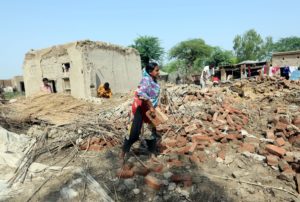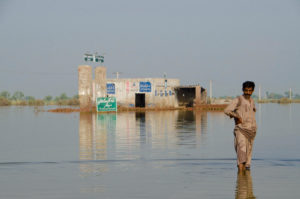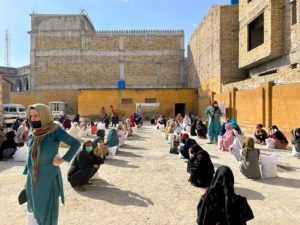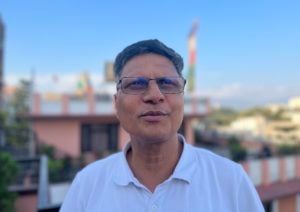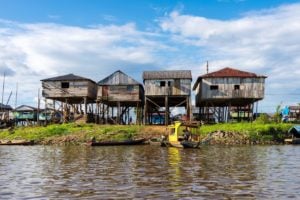Last August, Rano, a schoolteacher from Kewal Kohli, a village in the Mirpur Khas district of Sindh province in southeastern Pakistan, saw the mud hut where he lived wash away in devastating floods.
Just 8 kilometres away was a village called Pono, where a group of one-room bamboo houses had all withstood the force of the floods and remained intact. People’s houses “did not collapse [in the floods] and they were not forced to evacuate,” Rano tells The Third Pole. These houses provided shelter to people from neighbouring villages, including Rano and others from Kewal Kohli.
Rano found out through villagers that the houses were designed by Yasmeen Lari, one of Pakistan’s most celebrated architects. A team from her organisation, the Heritage Foundation of Pakistan (HFP), had taught community members to build the houses, which she designed. Inspired, Rano and others from his village contacted the company to ask for training on building the houses for their community.
A simple and sturdy solution
Beneath a slanted, conical roof made of grass, the house’s structure consists of eight bamboo panels – a material chosen for its resilience, Lari says. The panels are plastered with lime and mud, and designed with cross bracing – an X-shape which reinforces the structure. These are installed on a plinth made of lime brick, which raises it above ground, and the ground directly below the house is paved with porous pavement, a surface with a high percentage of air voids that allows water to pass through it and infiltrate the soil. Being constructed on higher ground with proper drainage meant that there was a lower risk of flood water entering the structure, Rano notes.
In Rano’s village, a total of 25 of these houses were built last October. Each house took just 10 days to build, at a cost of PKR 25,000 (USD 89), with the low cost down to the use of locally accessible materials such as mud and rice husk. The foundation paid for specialist materials and provided technical advice during construction, while house dwellers were tasked with obtaining material locally and providing construction labour.
Currently, the house’s design uses bamboo sourced from the central-eastern province of Punjab, though HFP has been encouraging locals to grow it themselves. Naheem Shah, project manager for the foundation, explains that this is so that, in the event of future disasters, people have the materials to rebuild their houses themselves.
Living in these houses, Rano says: “We feel safe now. There’s no fear of the roof collapsing on us… [and] we [don’t] feel the urge to sit outside when it rains.”
Building self-resilience
The Pakistan floods of 2022 were unprecedented in their magnitude, and wreaked havoc in Sindh and Balochistan provinces in Pakistan’s south. More than 1,700 people died, with 33 million affected and more than 8 million displaced. Nearly 900,000 homes were razed.
Pakistan has had more than two dozen mega floods in 75 years.
According to a recent study, the 2022 flood was caused by multiple days of extreme rainfall on wet antecedent conditions.
The flood was primarily driven by extreme precipitation, glacial-melt contribution, and an intense low-pressure system that developed over the land area due to the summer heat waves in May and June.
The study warned that extreme precipitation is projected to increase in a warming climate, and emphasised the need for adaptation and mitigation.
Lari, Pakista’s first woman architect, designed the bamboo homes in 2005 after an earthquake devastated Pakistan-administered Kashmir. Distribution of the house model was expanded to flood-hit areas of Sindh province, southeastern Pakistan, in 2011, where the foundation built at least 1,000 of the houses in Khairpur and Tando Allahyar districts as part of her housing programme she dubbed “green shelters for all”. Her work in humanitarian architecture led Lari to be awarded this year’s Royal Gold Medal from the Royal Institute of British Architects.
Lari’s housing model is based on the concepts of self-building using locally sourced materials and through teaching the community house-building skills. These allow the community to actively participate in building disaster-resilient homes and keep – and spread – the skills within the local community, rather than rely on outside help. To encourage self-reliance, HFP focuses on supplying skill and materials rather than financial aid. “The moment you start giving people a handout, that is the end of their own dignity,” Lari says. Disaster victims “are displaced, not handicapped; teach them the skills and they’ll do amazing things.”
Disaster victims are displaced, not handicapped; teach them the skills and they’ll do amazing thingsYasmeen Lari
But to ensure total self-sufficiency, Lari believes aid should extend beyond the house and into daily existence. “There are millions in my province alone who are without any water,” Lari says. “But you give them a house, and what about other things? How are they going to survive?” To that end, HFP also provides solar panels and hand pumps to communities, both of which are paid for by the foundation, which is funded by donors and sponsors.
The foundation has also made available online in-depth tutorials on building the house. As a result, Lari’s designs have been used by other NGOs such as Madat Balochistan, a community-led organisation in the mountainous southwestern province it is named for.
Maryam Jamali, co-founder of Madat Balochistan, tells The Third Pole that her organisation has built between 250 and 300 of the houses in the five months after the floods, largely in the Gandhaka area of Jaffarabad, a district in the province’s southeast which was badly hit by the floods.
Construction of the houses has generated employment, Jamali says, as typically, local carpenters produce the panels, and skilled labourers provide advice on structural integrity and assemble them with the homeowner.
The house design has been lauded for its versatility under different climate pressures. “Not only are they flood-proof, but also good for extreme heat – we experience 50C to 52C heat, and the frequency of heatwaves in our region has also increased,” explains Jamali. “The mud houses could withstand these temperatures, but they’d be easily annihilated by floods. With brick houses, the temperature is even higher inside, as concrete traps heat.”
Arbela, 30, a tenant farmer from the district, tells The Third Pole: “After the floods, we didn’t have any shelter. Our little kids were sitting in the open air, under the blazing September sun. At least now, our kids are safe.”
Another tenant farmer, Hakim, 50, agreed, saying: “Our families were left in the open air after the floods [destroyed our homes].” He recalls the severity of the 2022 floods. “We still had flood water in our feet when we came back from the canal bank [before these homes were constructed by Madat Balochistan],” he says. “These homes [will] keep us safe.”
Both Arbela and Hakim are landless tenant farmers who live on their landowner’s land, and are liable to eviction at any time. The ability to detach and rebuild elsewhere makes the new house design practical for their circumstances. As they are plastered to the ground with mud, uprooting the structure only takes digging the mud with a shovel, labelling the bamboo panels and reassembling them elsewhere, which Madat Balochistan has seen cases of.
Instead of lumping us all into the ‘poor, vulnerable people from Balochistan’ monolith, we need representation from each and every communityMaryam Jamali, co-founder of Madat Balochistan
In Balochistan, the government has not put any effort into rebuilding houses so far, says Jamali, and it is NGOs that have been leading initiatives. However, she notes, these are not community-led. “Designs and decisions are forced by the NGOs [on the people] in these initiatives,” she says.
But community-based decision-making and representation are integral to ensure climate resilience, she adds. “Every community has different needs, norms and cultures – instead of lumping us all into the ‘poor, vulnerable people from Balochistan’ monolith, we need representation from each and every community and diverse solutions.”
This has been evident in the case of HFP. Despite Lari’s house design’s seeming potential for use across all flood-prone areas, the model is not a one-size-fits-all solution, as seen in the case of the NGO, Balochistan Youth Action Committee (BYAC). It plans to build 40 houses and 10 public washrooms in the flood-affected district of Sohbatpur with disaster management organisation Hands Pakistan, and had initially considered using the bamboo model houses. But they encountered a major issue when drawing up their plans: pests that consume bamboo, the key structural material of the house.
“We were exploring the idea of [HFP’s] bamboo houses, but [from] doing on-ground research, we identified that bamboo would not be a sustainable material in this [region] because termites are a big issue,” says Sikander Bezanjo, co-founder of BYAC. The material they are using instead is brick that is locally produced in Sohbatpur. “It is something supplied in abundance there and locals see it as more sustainable and [a] long-term [solution],” Bezanjo notes.
A government trapped in old ways of thinking
As communities confront the gargantuan task of rebuilding, and amidst looming threats of more climate change-induced disasters battering the Hindu Kush Himalayan watershed, experts are emphasising the importance of climate-resilient, flood-proof structures in the region, which is home to 240 million people.
This is particularly important due to the poor state of the current housing stock and infrastructure. “Houses and infrastructure were built in areas with no-zoning laws, in low-lying areas and flood paths. Or, where the laws existed, they were ignored due to weak governance,” explains Ali Tauqeer Sheikh, an expert on climate change in Pakistan. He adds that construction standards “were all weak and poor… [They were the] same as in the colonial era, and had not been upgraded. That’s a primary source of vulnerability.” Sheikh notes that corruption is also to blame for inadequate housebuilding standards.
On top of the devastating loss of life, poorly constructed homes have had far-reaching economic impacts for Pakistan. Of the USD 30 billion in losses from the 2022 floods estimated by the government, USD 10 billion accounted for private losses that included housing, while around USD 7 billion was from damaged infrastructure like roads, bridges, power stations, educational buildings and hospitals, says Sheikh.
In Sindh, the government has established a not-for-profit company, the Sindh People’s Housing For Flood Affectees (SPHF), to build “resilient” houses made of cement and reinforced concrete. It disbursed USD 727 million allocated for reconstruction, USD 500 million of which was a loan from the World Bank. The funds are used by the beneficiaries to build their own houses with guidance from masons engaged by the company.
Since February, “SPHF has successfully disbursed funds to 1.8 million out of 2.1 million beneficiaries. Construction is in progress for 100,000 houses at various stages across Sindh,” Khalid Shaikh, director of SPHF, told The Third Pole in September.
To ensure climate resilience, the SPHF guidelines include “raising floor levels above the high flood level or adopting wet and dry floodproofing techniques to mitigate future risks, as well as ensuring proper roof drainage systems,” says Shaikh.
But Shahid Sayeed Khan, an environmental architect and founder of sustainable development NGO Indus Earth Trust, worries that these floodproofing guidelines are not enough, and that the government isn’t looking at the housing crisis through a climate change lens. “Since the government is building using reinforced concrete, they can only build a few ‘show houses’ [due to the material’s high cost]. This cannot resolve the housing problem because the poor in the rural areas cannot afford to have reinforced concrete,” he explains. Instead, he proposes, “we have to teach the people to build their own houses, using earth as a material source.”
At a cost of PKR 300,000 (USD 1,067) each, Lari says that the cost of these government-built houses is high and that HFP’s homes would be a much cheaper solution. “HFP homes cost just about PKR 25,000 (USD 89) per structure. Even if you multiply it by a million, it wouldn’t be a huge number,” she notes. “Certainly the USD 500 million dollars the World Bank has given will cover all the housing needed.”
But Shah, HFP’s project manager, says that the government has yet to respond to the foundation’s pitch on their bamboo houses.
To Lari, the government’s strategy is flawed. “Using concrete and steel comes with a high carbon footprint. Not only is it highly destructive to the environment, but [also] to people’s [lives],” she says. In contrast, her motto, as espoused in her do-it-yourself house model, has been “zero carbon, zero waste, zero donor – leading to zero poverty”.
